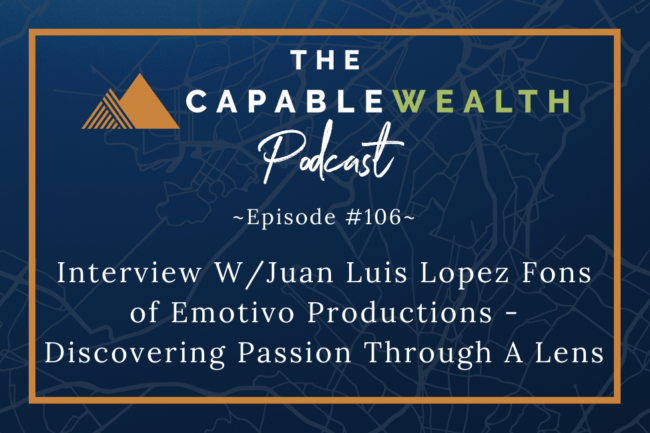Investing success does not lie in being able to pick which stock will outperform the next. True success will be achieved by following a core set of principles that will help increase your chances of success over the long term.
Over many years of research, reading, and investing, I have developed these core principles that help me stay on track.
Please use them wisely.
Principle #1 – Understand Your “Why” Before You Begin
Without a strong understanding of why you are investing it becomes easy to get side-tracked.
There is no shortage of “great ideas” to invest in. The important thing to remember when evaluating where to put your money is what the purpose of that money is. Ask yourself what that money will be used for in the future and how comfortable you’d be willing to put it at risk.
If it’s money you’ll soon need it’s probably not a good idea to take a lot of risk. And if it’s money you won’t need for a long time you can probably afford to take a little more risk, knowing you have plenty of time to recoup any potential losses.
Principle #2 – Use A Long-Term View
Patience is difficult for most people, and it’s even harder when you turn on the TV and hear dozens of opinions pulling you in different directions.
While investing, you need to take a long-term view. This means that you aren’t looking to time the market and pull your money in and out on a regular basis.
If you’ve done your research and believe you have a good investment that should be beneficial, allow it to play out. You should only look to replace it if there is some structural issue that changes its outlook. Just because an investment is going through a tough patch doesn’t mean it needs to be replaced.
Principle #3 – Control What You Can Control
When it comes to investing, there are certain things that are out of your control, and others that you most certainly can control.
A few ways to control the outcome of your portfolio:
- Keep your fees low
- Pay attention to tax liability
- Stick to your plan.
You can’t guarantee a rate of return, but you can guarantee a cost savings if you move from a mutual fund with a 2% fee to a passive index fund with .1% fee.
You can also save money by avoiding unnecessary taxation by holding onto investments for long-term capital gains instead of short-term capital gains.
Principle #4 – Have An Emergency Fund To Keep You On Track
An emergency fund doesn’t just help you pay for unexpected costs, it helps you stay on track with other objectives, like investing for future goals such as buying a home, saving for a child’s education, or retirement.
If you are putting money toward those goals, and an unexpected emergency happens, without an emergency fund you will be forced to stop allocating money to your goals and pay for the emergency. It is not just an inconvenience, it throws you off the path toward reaching those goals you hope to obtain.
An emergency fund allows you to keep things moving forward even if you are faced with an unexpected roadblock.
Principle #5 – Diversification & Asset Allocation Are A Must
“Don’t put all of your eggs in one basket,” as they say.
You have probably heard this many times before. In investing, diversification is one of the most important concepts that exists.
Asset Allocation is how you choose to split up your money into different areas.
By using both concepts, you will help to increase your chances of success.
Principle #6 – Rebalance Your Portfolio At Set Intervals
Over time, your portfolio will begin to change based on the performance of the investments.
For example, if you have two investments, each of which you put 50% of your money into, and one doubles and the other becomes worthless, you still have the same amount of money, but now it’s all in just one investment.
This is a simplified example, of course. But the point is, over time your portfolio allocation will change due to performance, so you have to check in at set intervals to rebalance back to where you are comfortable, keeping sure to have a diversified portfolio.
Principle #7 – Dollar Cost Averaging Is A Winning Strategy
This is the concept of investing pre-set amounts of money at regular intervals. I like to explain it as “diversifying across time,” because you aren’t investing all-at-once.
By doing so, it will help you minimize the potential for investing based on emotions, which is a real risk during big ups and downs in the market.
I wrote about how this specific strategy works in a post titled: “Should You Be Hoping For The Stock Market To Drop?” You can also read more about the strategy here.
Principle #8 – Use Low-Cost Passive Investments
As I mentioned in Principle #3, you need to control what you can control. Fees are one of those things.
For the average person, I’d recommend using low-cost investments like passive ETFs or index funds. These investment vehicles will give you broad exposure to different markets, and they will do so at a very low cost.
It can’t be overstated how much of a negative affect high-costs can have on your investment portfolio.
Over the course of a 30-40 investment timeframe (i.e. – a 30-year-old saving for retirement), you could lose up to 20-40% of your ending balance due to fees. EEK!
Principle #9 – Don’t Chase The “Next Big Thing”
There will always be someone telling you about some incredible investment idea. It could be a great tech stock they are investing in, some new exploratory drug company, or even the latest craze in recent years – Cryptocurrencies like Bitcoin.
I remember having a conversation with a friend that was preaching how a Bitcoin was going to become worth $1 million each. This was back in the fall of 2017, and at that time each Bitcoin was worth around $6,000. Time went on, and soon each Bitcoin was worth around $20,000. For a brief moment, I was kicking myself, and I even considered getting in on the action. But then I sat back and just remembered not to chase the “next big thing.”
In a blink of an eye, Bitcoin crashed, and it’s now trading back down under $6,000 per coin.
It could still become worth a ton of money, but no one knows for sure.
The point is to make sure you invest in something because you believe in its potential, not because everyone else is doing it.
Final Points
The reason you need principles is because you need to understand your foundation for how you invest.
Many investments will come and go, and there is no shortage of ideas for you to allocate your money toward.
Without understanding your own thought processes for how you’ll weed through everything, it will be impossibly difficult to attain success in the investment game.
Feel free to use my principles, or to find your own. But make sure you have something to fall back on in times of decision-making. Otherwise, you might be buying Bitcoin at $20,000, only to see it fall to $6,000…
Capably Yours,
















